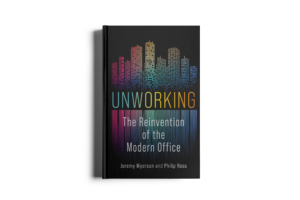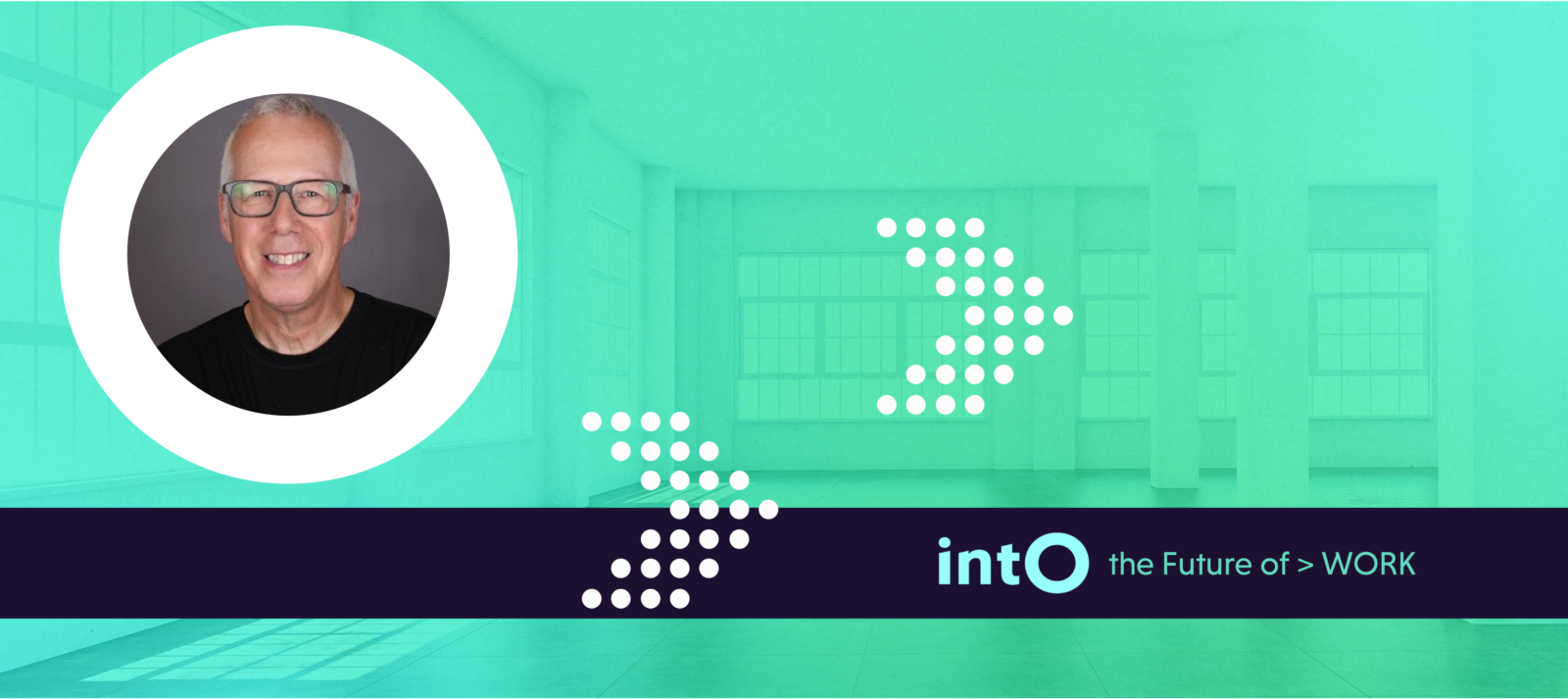Jeremy Myerson is Professor Emeritus at Royal College of Art where he co-founded the Helen Hamlyn Centre for Design. He’s also a world-renowned author, having published 20 books on subjects ranging from art, design and architecture, and is an advocate for people-centred design and innovation.
As the co-founder of WORKTECH Academy, he’s been at the epicentre of many discussions around the future of work for nearly a decade, which made him an essential contributor to our report intO the Future of > WORK 2022. Here’s a snippet of our conversation with him, where he shares his thoughts on hybrid and polycentric work, workplace consumerisation and the future role of the office.
Hi Jeremy. Tell us, how has your career been connected to the future of work?
For a number of years, I led a research group looking at the future of work in the city – that was one of my first direct connections with this area. In 2003, my colleague Philip Ross and I launched the WORKTECH conference series, which has now become the world’s leading conferencing and thought leadership series for workplace intelligence. Driving from our experience and connections established since starting those events, in 2016 we founded WORKTECH Academy, an online knowledge platform and global member network exploring the future of work and workplace. As you can see, I’ve been very interested in this subject for a long time.
Looking back at when you started WORKTECH Academy to where we are now, how has work and the workplace changed since then?
The pandemic has brought a lot of disruption to the workplace system, but it mainly accelerated some shifts that had been brewing for a while.
The main changes I’ve seen are around the idea of offices being the main location for work where people commute to and work from on a daily basis. With the lockdowns, that model was exposed to huge challenges and adaptations, and we realised that, actually, you don’t need to go to the office to do your job; you don’t have to work synchronously in one place, you can do it asynchronously in different places, teams can work remotely and it won’t cause an organisation to fall apart.
This idea that you need to travel to an office every day in order to get work done and for organisations to flourish was challenged by this giant, involuntary experiment when everyone suddenly had to work from home.
People knew that the future of work will be based around employees having more flexibility, using technology that allows for remote work – and, suddenly, the pandemic made us all spring into this future. Companies were able to digitally adapt their operations in a matter of days and weeks, as opposed to years. People just got on with it.
The big difference between before and now is that people have realised they have choice and autonomy; the pandemic helped to shift employees’ mindset in regards to where, how and when they work. Even companies that now want people back in the workplace are realising there is a big resistance.
In your opinion, what will be the long lasting effects of hybrid working?
I think the industrial type of workplace we’ve had for the last 100 years will be left behind. It will become a digital workplace where software will be king.
Physical settings will still be important, but the big change will be what you might call multichannel working as opposed to single channel working, or even omni channel working where people will work from a range of different spaces. There will be a kind of polycentric approach to work.
And for people, the office building will become important for different reasons, but it will probably be a place to convene for culture, brand, identity and community purposes; it will be less of a place to do private work, which you can do anywhere in a café or at home.
In general terms, I think the big legacies of hybrid working will be a much more distributed ecosystem of work, and much greater use of digital tools. And, even more so, we’ll see a much greater awareness of employees’ mental health and physical health.
Do you think there will be any other effects related to hierarchy or team structures?
It’s already happening. We’re seeing classic, top-down management failing in this new scenario, because they rely on people working in a physical space surrounded by a highly stratified environment. When you’re in a Zoom call, it feels much more democratic because you get to see everyone in their bedroom, or living room or wherever.
We’re also starting to see new forms of leadership – compassionate leadership, servant leadership, listening leadership, creative leadership. They also bring along new ways in which performance management is handled, for example.
The office has a dimension of time, but it also has a dimension of space. In the past, companies experimented a bit with flexi time, where maybe they let people work from home one day a week, or experimented with flexible settings. Now, in the hybrid era, they have to do both and it’s complicated.
On a macro lens, with all these changes in perception around office spaces, will there be any consequences when it comes to city planning?
If people travel from home to an office, they will expect a good experience in return. There’s no point for them to go into an office that feels like a morgue, with no one there or where colleagues are spending their days on Zoom calls and can’t talk to you. Offices will need to become convening spaces for social interaction. As I mentioned, if you want to do private solo work, you can do that elsewhere.
There are some interesting initiatives happening, like the 15-minute City in France or the idea of developing compact cities. I think polycentric work will lead to polycentric cities, and I do believe most urban areas across the globe will be affected.
And in terms of people’s mobility?
Well, one of the things putting people off commuting is the idea of sitting in an underground line for half an hour while being exposed to the risk of getting Covid. Other than for health reasons, public transport is a problem, especially when we think about pressure points in the system at certain times of the day – the infamous ‘rush hour’.
Micro-urban forms of mobility are a big part of this conversation. In cities like London, lots of people are already using electric scooters, and there has been a proliferation of cycle lanes. But this is as much about mobility as it is about climate and sustainability. I think a global public health crisis reminds us how vulnerable and interconnected we are.
Let’s look further into the future. What does the hybrid worker of 2040 look like?
The hybrid worker of 2040 has access to amazing technology and works seamlessly in a range of places. They have peripherals that they carry around with headsets and video cameras, which have been designed by the top brands – they won’t be the clunky plastic things that you get at the moment. I think fashion and mobile work technology will kind of fuse at some point.
There will also be a higher level of artificial intelligence and automation to help with workflows, daily work tasks and collaboration with colleagues. We’ll use more data and everything will be measured and monitored, buildings will be very intelligent and sentient, and even our health will be constantly monitored in relation to work tasks.
There will be a confluence of work, technology and health monitoring. It’s going to be an interesting period of innovation.
And what will the purpose of the office be in the next 10 years and beyond?
There’s going to be a consumerisation of the workplace, where offices will be used to attract employees the same way restaurants want to attract more consumers. I think the Great Resignation is really causing companies to pause and realise they need to provide better experiences for their employees. Why would you go into the office if it’s going to be a rubbish experience?
The days of companies renting lots of spaces and just fitting them out with fluorescent lights and rows of desks are gone. People don’t want to sit there all day with their headphones on, they may as well stay at home or go to a local café.
The office will be a space where colleagues get to interact, feel part of something bigger, and even get to enjoy their time there. I’m talking about massages, games, a nice food court space, yoga classes… It will become a sort of sanctuary, far beyond the idea of a place where you get to sit all day while doing your job.
Would the life values and behaviours of the hybrid worker change in 10 years time?
Well, I think for hybrid workers it’s not about work-life balance anymore – it’s work-life blend.
They will care more about how work feels for them, and purpose will become even more important. People will not just do their job to make money, they will want to be intellectually fulfilled and have more learning and training opportunities. Well qualified people will have the upper hand, and they will demand from organisations certain types of behaviours to suit their needs and expectations.

Unworking: The Reinvention of the Modern Office by Jeremy Myerson and Philip Ross (Reaktion Books 2022)
You can learn more about Jeremy’s work in his latest book, Unworking: The Reinvention of the Modern Office, where he and Philip Ross reflect on why we need to discard old ideas about the office and think more radically about the future.
This interview was originally conducted by our Project Lead, Anteja Klimek, in April 2022 for our intO the Future of > WORK 2022 report.

Posted on October 24th, 2022
Future of Work Research





